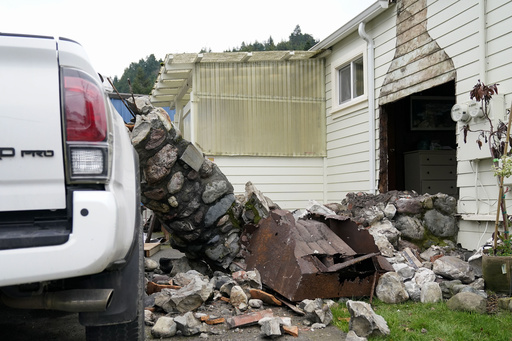SAN FRANCISCO — While driving through Northern California to visit family, Valerie Starkey experienced unexpected shaking that led her to believe her vehicle had malfunctioned, only to later discover it was a powerful earthquake that resulted in a tsunami alert affecting a vast stretch of the U.S. West Coast.
The earthquake, registering a magnitude of 7.0, struck on Thursday and had its epicenter in a region known for seismic activity, due to the convergence of three tectonic plates. This quake was the strongest in California since a 7.1-magnitude earthquake hit Ridgecrest in 2019.
Starkey, who serves as a Del Norte County supervisor for the town of Crescent City, was among the 5.3 million residents across nearly 500 miles of California and Oregon coasts who were placed under a tsunami warning for about an hour following the quake. Fortunately, no significant waves were reported, allowing the warning to be lifted.
“I thought my axles had fallen apart,” Starkey shared, reflecting on her initial reaction. “That’s what I was feeling … ‘My axles are broken now.’ I did not realize it was an earthquake.”
The quake struck at approximately 10:44 a.m. off the coast of Ferndale, a small city located in Humboldt County, roughly 130 miles from the Oregon border. The intense shaking was strong enough to topple items in grocery stores and prompt schoolchildren to take cover under their desks.
The tremor was felt as far south as San Francisco, around 270 miles away, where residents reported a gentle rolling motion. Smaller aftershocks followed, but thankfully, there were no immediate reports of major destruction or injuries.
The tsunami warning, activated shortly after the quake, extended from California’s Monterey Bay all the way north to Oregon.
“It was a strong quake. Our building shook. We’re fine, but I have a mess to clean up right now,” noted Julie Kreitzer, owner of a popular local store in Ferndale. She added, “I have to go. I have to try and salvage something for the holidays because it’s going to be a tough year.”
This region is recognized for its majestic redwood forests, picturesque mountains, and its role in the Emerald Triangle known for its marijuana production. In 2022, the area endured a magnitude 6.4 quake, which left many residents without essential services. According to seismologist Lucy Jones, this corner of California is a seismically active zone due to the meeting of three tectonic plates.
Shortly after the quake, residents in Northern California received alerts from the National Weather Service warning them of potential tsunami threats, urging them to “Get away from coastal waters. Move to high ground or inland now. Keep away from the coast until local officials say it is safe to return.”
Many municipalities encouraged residents to evacuate to safer, elevated areas. In Santa Cruz, authorities cleared the region’s primary beach and taped off access points for safety. Aerial images depicted significant traffic congestion as cars headed toward higher elevations in areas like Half Moon Bay, located south of San Francisco.
Cindy Vosburg, head of the Crescent City-Del Norte County Chamber of Commerce, reported hearing alarms just before the quake struck, with her city’s cultural center exhibiting noticeable creaks during the shaking.
In response to the earthquake, the President was briefed, and FEMA officials began coordinating with local and state authorities in California and Oregon. Governor Gavin Newsom also declared a state of emergency to facilitate prompt assistance to affected coastal areas.
City crews in Eureka, the largest municipality in the region, began assessing potential damage, with the mayor describing swaying lights in her workplace. Students were evacuated from their school after the quake, showcasing the panic but also strength among the children.
The local sheriff mentioned minor issues such as cracks appearing in some homes and instances of shattered glass, but overall, it was managed without severe incidents.
The BART (Bay Area Rapid Transit) system temporarily halted operations through its underwater tunnel, and visitors at the San Francisco Zoo were evacuated as a precaution.
The earthquake was classified as a strike-slip event, which generally shifts horizontally and is less likely to create tsunamis, in contrast to more vertical earthquakes, as explained by the National Weather Service’s tsunami program manager.



